System Module
From Computer History Wiki
System Modules (also sometimes known as System Building Blocks) were a DEC modular digital logic family which preceded the later FLIP CHIPs. They connected to the units they were plugged into via a set of 22 gold-plated discrete pins along one edge.
They used transistor inverter circuits, with the transistors operating saturated, to avoid dependence on tight tolerances; they ran off -3V. Intended for prototyping as well as production, they included design features intended to avoid damage. They came with design advice which included loading rules, and wiring instructions.
They were available in three compatible speed lines:
- 4000-Series: the basic series, speeds ranged from 500 KHz to 1 MHz
- 1000-Series: used where extra standard output loads, or -3V sources, were needed
- 6000-Series: higher speeds, 5 MHz to 10 Mhz
In addition, special modules were available for purposes such as A/D conversion, etc.
